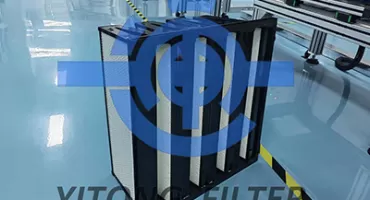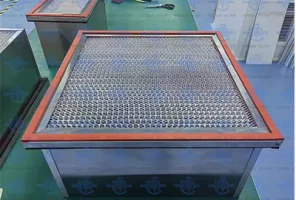 April 24, 2025
April 24, 2025
Turbine systems—whether gas, steam, or industrial—operate in some of the harshest environments on the planet. They demand extreme precision, high efficiency, and unwavering reliability. One critical component that plays a major role in protecting these systems is the high temperature filter.
These filters are engineered to handle intense heat while maintaining excellent filtration performance, making them essential for safeguarding turbine components from particulate damage. In this post, we’ll explore what high temperature filters are, why they matter in turbine applications, and how to choose the right one for your system.
A high temperature filter is a type of industrial air filter designed to function reliably in environments where temperatures can reach or exceed 250°C (482°F)—sometimes even higher. These filters are built using heat-resistant materials such as stainless steel, glass fiber media, ceramic components, and silicone gaskets.
In turbines, where airflow is rapid and temperatures can be extreme, high temperature filters protect the machinery by capturing dust, ash, oil mist, and other fine particulates that can erode blades, clog components, or reduce combustion efficiency.
1. Protect Turbine Blades and Components
Turbines are highly sensitive to particle contamination. Even small particles can cause erosion, reduce aerodynamic efficiency, and result in costly downtime. High temperature filters stop harmful particles before they reach the compressor or combustion chamber.
2. Support High-Efficiency Combustion
Clean air ensures optimal fuel combustion in gas turbines. Particulate-free intake air also helps prevent fouling and corrosion in downstream systems, which is vital for consistent power generation.
3. Enhance System Lifespan
Using high-performance filtration reduces the wear and tear on internal components, cutting down on maintenance costs and extending the life of turbines and auxiliary equipment.
4. Withstand Harsh Operating Conditions
In power plants and industrial facilities, ambient air near turbines is often hot, dusty, or chemically reactive. High temperature filters are engineered to survive and perform in these punishing environments.
- Air Inlet Systems – For gas turbines, filtering the ambient air before it enters the compressor.
- Exhaust Filtration – Capturing particles from hot exhaust gases in environmental control systems.
- Steam Turbine Sealing Systems – Preventing contamination in seal air flows exposed to elevated temperatures.
- Auxiliary Equipment – Including high-temperature filtration for hydraulic or lubrication systems.
| Filter Type | Description | Max Operating Temperature |
|---|---|---|
| Panel Filters | Rigid, high-efficiency filters with extended surface area | Up to 300°C |
| HEPA Filters | Cylindrical design, used in specialized turbine systems | 400°C and above |
| Sintered Metal Filters | Reusable filters with high strength and heat resistance | Up to 500°C |
To perform under high thermal stress, these filters are made from specialized materials:
- Filter Media: Borosilicate glass fiber, sintered stainless steel mesh, or ceramic fibers
- Frame/Body: Stainless steel or galvanized steel to resist corrosion and deformation
- Sealants and Gaskets: Silicone, fiberglass, or ceramic-based materials that can maintain seals at high temperatures
These materials are selected based on operating temperature, airflow rate, and the specific contaminants involved.
✅ Stable Performance Under Heat: No sagging, warping, or media burnout even during continuous high-temp operations
✅ High Filtration Efficiency: Capable of capturing particles as small as 0.3 microns
✅ Improved Energy Efficiency: Cleaner airflow reduces compressor fouling and backpressure
✅ Compliance with Environmental Regulations: Helps reduce emissions and particulate output
✅ Extended Maintenance Intervals: Durable filters mean fewer shutdowns and reduced labor costs
When choosing a high temperature filter for turbine use, consider the following:
✔ Operating Temperature
Confirm the maximum and continuous operating temperatures. Choose a filter rated at least 10–20% higher than the expected peak temperature for safety.
✔ Efficiency Requirements
For gas turbines in sensitive environments, opt for HEPA or EPA-rated filters. For industrial power turbines, a coarse or fine filter may suffice depending on location.
✔ Airflow and Pressure Drop
Ensure the filter can handle your system’s airflow volume without exceeding pressure drop limitations, which can strain the turbine’s intake system.
✔ Contaminant Profile
Are you filtering dust, oil vapor, salt aerosols, or chemical particles? The answer will influence your choice of media and construction.
✔ Installation Space and Orientation
Turbine air filtration housings can be tight and complex. Make sure the filter fits precisely and is easy to replace.
To keep high temperature turbine filters working efficiently:
- Inspect regularly: Especially in dusty or high-humidity environments
- Monitor pressure drop: A rising pressure drop signals clogging or degradation
- Replace proactively: Don’t wait for failure—replace based on service hours or condition
- Choose quality: Use OEM or certified third-party filters designed for your system
Q: Can I reuse high temperature filters?
Some types, like sintered metal filters, are washable and reusable. Most fiber-based filters are disposable and should be replaced after their service life.
Q: What’s the difference between high temperature HEPA and standard HEPA?
High temperature HEPA filters are built with heat-resistant frames, gaskets, and sealants, making them suitable for temperatures above 120°C. Standard HEPA filters cannot survive in these conditions.
Q: How often should turbine filters be replaced?
It depends on operating conditions, but most are replaced every 6 to 12 months. In dusty or industrial environments, more frequent replacement may be necessary.
High temperature filters are an essential line of defense in turbine systems—whether used in power generation, industrial processing, or mechanical drive applications. They provide vital protection against airborne contaminants that can reduce efficiency, damage components, or cause catastrophic failures.
By choosing the right filter for your turbine system and maintaining it properly, you can ensure maximum uptime, better performance, and longer equipment life.
 Oct. 12, 2023
H10 V-Bank Type HEPA Filter
Oct. 12, 2023
H10 V-Bank Type HEPA Filter
 Mar. 18, 2024
Why Do I Need a HEPA Filter?
Mar. 18, 2024
Why Do I Need a HEPA Filter?
 Nov. 25, 2024
High-Temperature Resistant Air Filters for Paint Spray Booths
Nov. 25, 2024
High-Temperature Resistant Air Filters for Paint Spray Booths